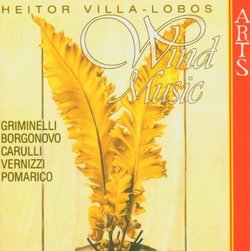| All Artists: Heitor Villa-Lobos Title: Villa-Lobos: Wind Music Members Wishing: 0 Total Copies: 0 Label: Arts Music Release Date: 6/18/1996 Genre: Classical Styles: Chamber Music, Historical Periods, Modern, 20th, & 21st Century Number of Discs: 1 SwapaCD Credits: 1 UPCs: 600554720029, 036244720022 |
Search - Heitor Villa-Lobos :: Villa-Lobos: Wind Music
 | Heitor Villa-Lobos Villa-Lobos: Wind Music Genre: Classical
|
Larger Image |
CD Details |
CD ReviewsAdmirable and pitifully overlooked pieces of the chamber mus Hiram Gomez Pardo | Valencia, Venezuela | 08/27/2008 (5 out of 5 stars) "The chamber music for wind instruments in the XX century was fully developed by two composers: Carl Nielsen and Heitor Villalobos. Curiously both of them were born in the XIX century (Nielsen in 1865 and Villalobos in 1887).
Heitor Villalobos was one of the great talents of the last century and undoubtedly, the most important Latin American composer ever born. There's an aspect almost unknown in his life. In 1912 (when the composer was 25) the composer accompanied an expedition to the interior of Brazil to study the music of the inland Indian tribes, remaining for two years and like Bartok, collecting folk songs from the various Indian, African and city cultures in Brazil. Later in 1929 , he would compile these folk melodies in a book titled "The soul of Brazil". In 1922 Villalobos went to Paris and during four year he sojourned there. So we have a composer historically imbued into the Impressionistic flow, therefore we should not to amaze the odd scenes from the Brazilian jungle, guttural sounds of jungle drums and even a freight train slowing down and coming to a standstill. So, we should note that the Trio for oboe, clarinet and bassoon antedated two years the famous Honneger's Pacific 231 (composed in 1923). On the other hand, we have that the quintet in form of chorus was completed in 1928 in Paris, therefore it accuses a curious the musical newness of Paris spiced with a certain Respighian Neo Modernist accent, unique in its style by then and his reminded Brazilian Impressions. The quartet for oboe, clarinet, bassoon and flute was completed in Rio de Janeiro in 1928. It reflects somehow, his notable stylistic maturity, the brilliant formal construction is a clear indicative. The praised artistic effort of this ensemble has been widely rewarded around the world, because the Quartet and the Quintet had to wait more than twenty five years ago until May 1954 to be premiered just by the new art quintet wind ensemble in New York city. " |

 Track Listings (13) - Disc #1
Track Listings (13) - Disc #1